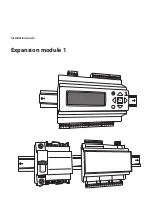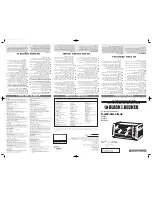
90
13.1 - Operating
Before starting the heater, the following
must be done.
13.1.1 - User instructions
The user must be correctly instructed
by the installer, on how to operate the
heater, in particular:
Make sure that the user understands
that combustion air and ventilation
openings must not be restricted/
closed/ or mdi
fi
ed in any way.
Make sure that the user is informed
of all the special measures to be
taken for combustion air inlet and
discharging
fl
ue gases, and that
these must not be modi
fi
ed in any
way.
Make sure that the user keeps this
manual and all other documentation
included with the heater.
Make sure that the user understands
never to tamper with gas control
settings and the risk of CO poisoning
should an unauthorized individual do
so.
Make sure that the user knows how
to adjust temperatures, controls and
the room thermostats for maximum
ef
fi
ciency.
13.1.2 - Filling the
condensate and
neutralizing box
The condensate and neutralizing
box is positioned inside the heater
as shown in Figures 3-3 through 3-8,
item “3”. It must be
fi
lled with water to
prevent the leakage of
fl
ue gases from
the condensate drainpipe, item “5” in
Figures 3-3 through 3-8. To
fi
ll and
inspect the condensate box proceed
follow Section 15.6.
WARNING!!!
If heater stays
off for more than 3 months,
repeat the above operation to
again fi ll the condensate trap.
Failure to follow this warning
could result in excessive levels
of carbon monoxide, which can
result in severe personal injury
or death!
13 - START-UP
13.1.3 - Filling the heating
system
WARNING!!!
If this
appliance is used like a direct
fi re potable water heater, never
use additives or toxic heater
treatment chemicals in the
water system as they can cause
serious health problems or
possibly death.
WARNING!!!
Never use
non-approved additives or toxic
heater treatment chemicals in
the heating system as they can
cause serious health problems
or possibly death. Any additives
introduced into the heating
system must be recognized as
safe by the United States Food
and Drug Administration.
CAUTION!!!
The heating system
must be fi lled with clean water
and with maximum hardness of
TDS 200 ppm. Contaminated or
harder water can damage the
heat exchanger.
CAUTION!!!
The water’s pH must
fall within the following limit:
7.5<pH<9.5 and if the system
contains aluminium parts, it
must be 7.5<pH<8.5. This pH
value must be measured after
steady condition and after air
purging operations has been
done (death water condition).
Water out from the above pH
values can result in premature
heat exchanger damage.
To
fi
ll the heating system, proceed as
follows:
1. open any automatic air vent in the
heating system;
2. open the
fi
ll valve and proceed to
fi
ll the heating system and boiler
until the pressure gauge, item “M” in
Figure 14-1, reads the pressure for
that the heating system is sized and
“FILL” disappears from the display;
(“FILL” displaing is set at 15PSI.
If you want to increase the “FILL”
intervention level, set parameter
3022 to the desired value (See
Section 19)
3. check that there is no water leaking
from the
fi
ttings. If there is, the leaks
must be eliminated;
4. close the
fi
ll valve;
5. check the pressure gauge during
the purging process. If the pressure
has dropped, re-open the
fi
ll valve
to bring the pressure back to the
desired value.
13.2 - General
warnings concerning
gas supply
When starting up the heater for the
fi
rst
time the following must be checked:
That the heater is supplied with the
type of fuel that it is con
fi
gured to
use. Read Section 12.
That the gas supply system is
provided with all the safety devices
and controls required under current
national and local codes.
That the vent and combustion air
terminals are properly connected
(see Section 11) and free from any
blockages.
That the condensate drain tube is
properly connected (see Section 9).
CAUTION!!!
To avoid corrosion
inside heat exchanger, gas used
should have sulphur rates inside
maximum annual peak over a
short period of time of 150 mg/
m3 and an annual average of 30
mg/m3.
WARNING!!!
If you smell gas:
Do not try to light any appliance.
Do not touch any electrical
switch. Do not use any phone in
your building.
Immediately call your gas
supplier from a neighbor’s
phone. Follow the gas supplier’s
instructions.
If you cannot reach your gas
supplier, call the fi re depart-ment.
Failure to follow the above steps can
result in a fi re or explosion causing
property damage, personal injury or
loss of life!
Summary of Contents for Boiler
Page 3: ...3 SAFETY INSTRUCTIONS ...
Page 5: ...5 SAFETY INSTRUCTIONS ...
Page 122: ...122 15 MAINTENANCE ...
Page 126: ...126 17 SPARE PARTS Spare parts ...
Page 129: ...129 17 SPARE PARTS 50 48 50 49 53 56 57 55 54 58 47 52 48 52 51 55 52 020010 03 006 199 ...
Page 152: ...20 SEQUENCE OF OPERATION for BOILER ...
















































